by B.B. Pelletier
Today, I’ll show you the camera I use, and I’ll talk about photographing pellets, plus how to take macro shots without a macro mode. Let’s do the macro mode first.
Connect the dots
Many of you have never opened the manual that came with your camera. You know it has more features than you use, but as long as it takes nice group photos, you really aren’t interested. You have what is known as a point-and-shoot camera. It’s time to face the facts. If we were talking film cameras, there are things you can do with even a cheap camera – like use a film with a lower ISO number. With a digital camera, you have software that adjusts the ISO (film speed, meaning how grainy the film looks after its developed), but the “size” of the image produced means a lot more. The size of the image in the digital world means the number of dots in it, at 72 dots per inch (on most cameras). And here’s the bottom line – if your camera has only two megapixles (the number of dots the image is wide times the number of dots high it is), there is nothing I can do for you. Your resolution is too low to do what I’m about to describe.
Where megapixels count
However, you would almost have to have a dinosaur camera to have that low a resolution. Most of you have at least 5 megapixels or more, and it’s hard to buy a camera these days that doesn’t have at least 7. The problem is that most of us are using our cameras in the default mode, which the camera maker assumed meant taking pictures for the internet. They know most of you don’t know how to get the pictures out of your camera and printed on paper! So, the default mode of your camera uses about 0.3 megapixles – even though it says 7.2 on the front of the camera in shiny letters. To put it into automotive terms, you have pulled 7 of the 8 sparkplugs out of your car’s engine to save gas, and then you wonder why it won’t go faster than 15 m.p.h.
Read the manual and set your camera on the highest resolution it’s capable of – and you may discover that instead of 335 photos you can now only take 7 because your memory card is too small. If so, you may want to upgrade. Both my cameras call this the “Quality” setting, and it isn’t that easy to find in the manual. On my point-and-shoot camera, the quality is a menu selection, but on the bigger camera it’s a dedicated button.
Taking a macro picture without the macro mode
When you take the picture at a close but non-macro setting, you’ll be enlarging the image in software. Yesterday, I showed you some bullets that looked like this:
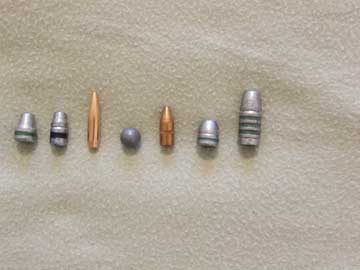
Here is what I can do with that image because my camera is set on the highest quality or resolution:
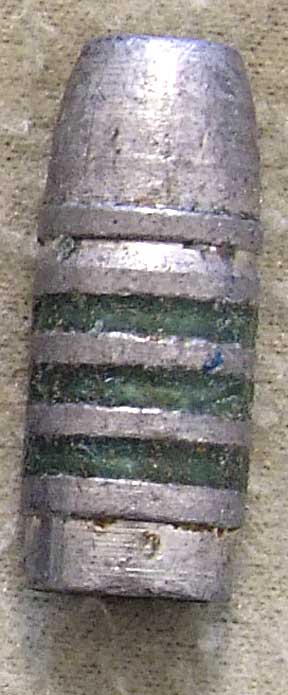
Photographing pellets
Now for the toughie. Pellets are difficult to photograph because it’s hard to get close enough to them even in the macro mode. That’s why I love the second, super-macro mode, of my Fuji S9100 camera (the big one). I can get almost 1:1 images, and, with this camera, that means a photo of a dime can be a magazine-quality, full-page spread. I don’t usually need anything that big for most work. Although I use super macro, I don’t get close enough for that much enlargement.
To cancel the foreground and background I use a sheet of printer paper held down in front by tape and in the back by a weight. I have photographed this setup for you to see what I mean.
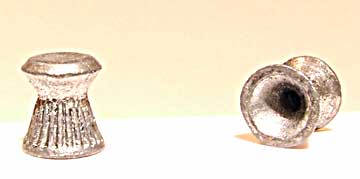
The camera was casting a shadow, so I painted the pellets with light like I described in an earlier segment of this report. The lens was about 1.5 inches from the subject.
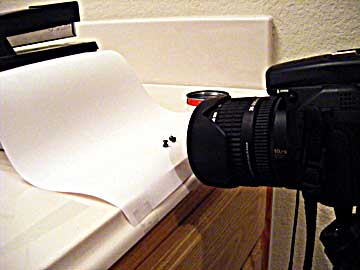
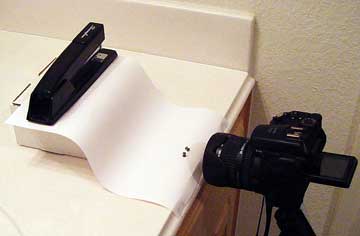
My big camera
I use a Fuji Finepix S9100 camera for all my serious work. Although it doesn’t have interchangeable lenses, the one lens it has is razor-sharp and zooms from a true 28mm to 300mm! It also has ISO speeds from 80 to 1600. At 1600, I can hand-hold the camera in a dark barn and get good closeups without blurring. My friend, Earl McDonald, who is the lead photographer at the National Archives, has used this camera in just 3 foot-candles of light, which is darker than most restaurants. The camera focused fine and held the shutter open as long as required.
This camera is not a professional digital camera, but it has many of the features I need for professional work. And it also shoots video, so I no longer have to take a separate video camera to airgun shows. They give these things away for as little as $335 on the internet. It takes pictures with up to 9 megapixels, which is 50 percent more than the Fuji S2 professional camera. I’ve been using it for three years and I recommended it to Pyramyd AIR for all their product photography. I cannot think of a better camera for less money.
Thanks for yet another wonderful photography post!
I have been following the series, and trying to work on my firearms photography technique. One thing, though, coninues to baffle me – the lighting…
Even using two 300W incandescent workshop lights on 7-foot tripods pointed at a white ceiling to provide diffuse reflected light, the photos I’m taking of arms lying on the floor, using my Canon 350D from a tripod are still turning out very dark, despite using a beige/tan cloth as a neutral, non-white background. There is too much red in the histogram too, but I suppose I can correct the WB either on the camera or on the PC.
Do I need to up the ISO (from 100), or pick a long exposure, or both? If I go for ong exposure, will theat mean a small aperture, and shallow depth-of-field?
Still grappling with it. Thanks for all the advice.
Hey BB, this is a bit off topic, but….
I decided to take the plunge and get one of the Norica Youth air rifles you mentioned a while back. Hopefully I’ll get it within the next week or so and I can “give it a go”. I tried doing some research on the model and I found some scant information, mostly on Spanish sites, so babelfish came in handy. From what I’ve been able to see though, it’s based on the Norica model 61, an airgun that they’ve been making since 1961. Anyway, it seemed to be well liked by those who used it.
Al in CT
B.B.
What is the link to guest blog? You mention it few times but I can’t find it.
Ivan
Denis,
Set your Camera to Manual Exposer, then start by opening up about 2 stops from what the meter is telling you. A light meter in the camera thinks of all light being 18% gray, so when its views a lot of white it wants to make it gray. Kind of like shooting in the snow.
So if your camera is telling you to shoot at 1/30th at F/8 you would need to adjust the shutter speed to 1/8th at F/8.
If you don’t have manual as a setting and you need to use Auto the camera should have an over and under exposer compensation. You would set this to 2 stops over exposer to lighten the final image.
As far as the color, If you can set the color temp. manualy use the setting for incandescent/tungsten light. The icon for this setting looks like a lightbulb.
This should help.
Joe G from Jersey
B.B. & All
I wish I had found the Fuji Finepix S9100..but they are so popular, they were sold out, and I didn’t want to wait for an online shipment. Plus, I like to spend at locally owned shops, if I can…
So my local camera shop convinced me that the Cannon Power shot A720IS is just about as good, and it was on sale for $200 from $400…so I got one and have been learning to “shoot” it, with your help, thank you very much…(still like “shooting” air guns more, but liking it a lot).
Like you say most of us, me included, don’t like to take the time to read how to use a new toy, (maybe that’s because, most often, the instructions are so crappy)… I just want to open it and use it perfectly every time, for whatever I want it to do…
Not in the moment, always in the future..grasshopper… I loved that old “Kung Fu” show, is that how you spell it?..you know the one with David Carradine, or something like that…
I am hoping to learn the video mode, and take some short movies of field target shooting…I hope to get one from behind the shooter, and then zoom in on the target and watch it get hit…..Will you get into the video mode on your blog? Or do I have to read the manual?..
Just kidding….I will read it and hope for a blog…
Wayne,
Ashland Air Rifle Range
Wayne,
Yes, let’s see some photos and videos of the airgun range.
Matt61
Matt61,
That is the goal to do live video of the shooters and their targets….so your friends can watch you shoot, or you can take home a disk, and watch your technique and get better…
Or you might be interested in the gun the person is shooting….and how it performs….
With “UTUBE” I hope it will be easy….. I a looking for a member to run this dept……anyone want to play…
Wayne,
Ashland Air Rifle Range
A good primer on another great hobby! Thanks B.B. (or whoever you are). Keep up the good work.
Rick
Denis,
It sounds like you are running your camera on manual. I usually run mine on aperture priority and use a lightness adjustment on the camera to brighten the image. Of course I can do everything in Photoshop, but the more I do with the camera, the less work there is later.
Don’t increase your ISO. Pick a longer exposure and try to force a wash-out of color. On the way there, you will find the ideal exposure time.
Also, try setting the color temperature as Jersey Joe advises. That makes a world of difference.
B.B.
Al in CT,
Please give us a report after you’ve shot the Norica Young a bit.
B.B.
Ivan,
Write to:
blogger@pyramydair.com
B.B.
Wayne,
That would be great. And maybe you can film someone carrying out B.B.s idea of firing with a laser light so that the viewer can see how the sights move before a shot. You can see what kind of groups a person shoots then have them mount the light to see how they do it.
Matt61
Jersey Joe, B.B,
many thanks. I have been running on Canon’s “P” mode, which is pretty much “point-and-shoot, but no flash” plus auto white balance.
I’ll try what you suggest, and let you know. Thanks!
Denis
Matt61,
I had not heard of that one…that would be so cool…I am sure people would love to watch the movement and solidness of the the shooter…and the shooter see afterward on tape his movements…that would be very hot…
or cool…I’m not sure..
I just got a barely used IZH61, from someone who said he wanted more power and was thinking of rws850 co2. (PA keeps slipping the date, to get the 3 I’ve got on order, now its 8/8, must be hard to get those Russians to come to work,)…I have not even opened the box of the IZH61…I am swimming in guns to test now…but, I really don’t want to shoot anything but the Air Arms S410 10 shot repeater..Save your money folks, and get one of the best right from the start..
Wayne,
Ashland Air Rifle Range
the canon G9 looks good. Its relatively compact and is a 210-mm equivalent. With the 3x lens & adaptor your up to 630-mm! Not to mention 12.1 mp.
Wayne,
You’re really living the dream with all of your airguns, and I will act out my fantasies through you!
Maybe you can have a shooting class that combines an attached laser light, videotape of the shooter’s technique (a big deal in swimming which is another interest of mine) and graduated distances to shoot as B.B. described in his blog about teaching someone to shoot an air pistol.
All of this would be worlds away from my year of smallbore shooting in high school which consisted of firing off rounds while waiting for the coach to shout at you or, in one case, sneak up behind, grab my ankles and slam them into the concrete to change my prone position. No wonder it took me 20 years to get back into shooting.
Let me know what you think of the IZH 61. I know the S410 is awfully good. Maybe someday.
Matt61
Canon is a leader in digital camera technology. Their professional camera now has over 17 megapixels and some of the best software on the market. It has a full-sized CCD, so all your Cannon 35mm lenses will image the same size with the digital.
B.B.
Matt61,
I’ll have to go back and read all the pistol shooting blog, I missed parts of it…this is getting more exciting all the time..I love the feedback…thank you all…
Hey, you don’t have to live your fantasy through me…move to Oregon and join the team….
We also are looking for a first class air gun “tech”, or is it “tunener”..(this is hard, trying to get the terms right)
I’m sure I’ll get tired of the S410 in a few years and open the box to the IZH 61…
Just kidding…Randy & I (oopps did it again…Randy and me) will probably check it out tonight…
Wayne,
Ashland Air Rifle Range
BB,
Unfortunately I just received an email from pyramyd stating that they are out of the Norica for now. I think I may pick up something else to tide me over for a bit.
Al in CT
Al in CT,
The last time I looked in the used inventory at PA, they had a Beeman RS1 for $132…you might check it out…this is much larger and more powerful than the Norica. Our RS1s shoot .177 10.6 beeman kodiak at 781fps and 7.0 hobbys at 954 fps average…They feel like about 7 lbs without a scope, shoulder nice and have good balance..
With the leapers 3-9x40AO and accushot one piece high mount, they have been very solid, and accurate, they won’t keep up with the TX200, but, I think they’re a great value in a springer..they have a little twist in the recoil, that knocks me off target on some shots but if someone tuned it…they would really have a nice smooth firing, accurate, inexpensive springer…I’m hoping durable, too. We have 3,000 shots on two of them, and so far so good….
In a smaller springer, go for the Beeman HW-30…it’s only 3 times the price…but you’ll be able to give it to your grandkids 100 years from now…
Of course, I’m still a novice at this, only seven months of 4 to 6 hours a day testing for the future air rifle range…before that I had not shot an air rifle since I was 12 or so…(1962)….How’s that for a “crash course”….so take this as semi-novice feedback…
Wayne,
Ashland Air Rifle Range
Al in CT,
If they say they are out of the Noricas, it’s probably for good. There were less than 30 guns, as far as I know.
B.B.
A little update on my progress – I switched the white-balance to “incandescent”, and set the camera to use auto exposure bracketing. The difference is amazing! The photos with +2 stops of exposure turned out really well – true colours and plenty of detail. Now I just need to try seting a really low aperture value to see the effect on the depth of field. Many, many thanks for the advice.
Some folks who don’t have close-up capabilities with their camera could use photographic + (plus) lenses. They come in +1, +2, +3 and can be stacked for more close-up power, i.e. +3 with +2 to get a +5. Use your view screen to check focus and composition. Of course, your camera must have manual focus capabilities to use these.
These lenses usually come in a small case that can be attached to the camera carrying strap.
If you like flat lighting, a circle light made from a circular neon bulb is ideal. Just slip it over the lens behind the outer ring and it’ll work great. The center brace just slips off the bulb.
Digital cameras usually color correct automatically, if the neon isn’t pure white. Be sure to cover your electronic flash with black tape.
I’ve used all the above and know they work.